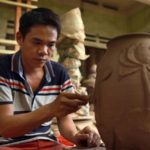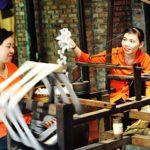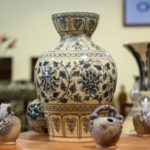Pottery craftsman To Thanh Son welcomed guests to his workshop, Thuan An Duong, in the renowned Bat Trang pottery village of Gia Lam District with a poem he penned about the age-old craft adorning the entrance:
“The thousand-year-old craft of pottery,
Where stories of history are embedded in clay.
Come to Thuan An Duong,
Where the skill of pottery makers is on display.”
A whole blazing life, full of passion and enthusiasm, awaits you!
Millions of works of art have been created over the centuries, with many of them having a lasting impact on the world. From the ancient murals of Egypt to the iconic sculptures of the Renaissance to the modern masterpieces of the 20th century, art has the power to inspire, challenge, and awe. Whether it’s a painting, a photograph, a sculpture, or a performance, art has the potential to move us and to shape our understanding of the world.
Hands covered with clay – the sensation is one of pure delight. The cool, damp texture of the clay, the way it oozes between your fingers – it’s almost magical. Working with clay can be therapeutic, a way to relax and unwind, or a way to create something beautiful. Whether you’re a novice or an experienced potter, working with clay can bring a feeling of joy and accomplishment. So don’t be afraid to get your hands dirty and explore the wonderful world of clay!
Put your best foot forward and strive for success in your chosen career path – “All for this career”!
The renowned potter spoke with local media about Bat Trang pottery artists’ creativity and the traditional craft village market. He emphasized the quintessential nature of the craft, and discussed how it has evolved over time. He also highlighted the importance of preserving the craft, and the ways in which it has been adapted to contemporary life. The potter also shared how the craft village market has become a popular destination for tourists, and how it has become a source of pride for the local community.
 |
| The renowned pottery craftsman, To Thanh Son, is from Bat Trang Pottery Village of Gia Lam District in Hanoi. Photo: Thuong hieu & San pham |
Do you need to go through a whole process of gaining experience in order to accomplish the seemingly impossible task of fitting the entire universe into a small basin?
Since its inception, ceramics have been one of the most beloved forms of decorative art. These beautiful pieces of artwork require a combination of functionality, artistry, soil, water, and masterful hands to be crafted. Without these elements, the ceramic masterpieces we know and adore today wouldn’t exist. From the most primitive of materials to the most complex, the art of ceramics is truly remarkable and should be celebrated.
To my mind, a competent and successful ceramist requires not only enthusiasm and passion, but also dexterous hands and an appreciation for the local culture. As someone who has been involved in the craft of ceramics since childhood, and who is now close to 70 years old, I can personally attest to the importance of these qualities. We are often referred to as ‘bluebloods’, and I take pride in being part of this group.
After completing my military service in the early 1980s, I decided to pursue a career in the traditional craftsmanship that had been passed down through generations. I received instruction from the masters in my village in various areas, such as shaping, enameling, and coloring – including the mysterious technique of heat-related coloring in the kiln. However, it was not easy for inexperienced people like me to enter the market and do business during the period of economic subsidies.
I suddenly remembered the words of my friend and teacher-painter, Prof. Tran Khanh Chuong, that “For ceramics to become sustainable and develop, it must be promoted based on traditional ceramics.” His advice put me on the right track and gave me the impetus I needed to pursue my passion for creating sustainable, traditional ceramics.
 |
| Artisan To Thanh Son (second from left) greeted visitors to his workshop in Bat Trang Pottery Village. Photo: Cao Thanh Son |
Bat Trang artisans have been developing traditional ceramics in many directions over the years. They have experimented with different glazes, glazing techniques, and firing temperatures to create a variety of unique and intricate ceramic pieces. Additionally, they have also diversified their designs to include items such as vases, plates, bowls, and even sculptures. In recent years, they have even begun producing pieces that feature both traditional and modern motifs, allowing them to appeal to a wider range of customers. This development of traditional ceramics has allowed Bat Trang artisans to remain relevant and successful in today’s market.
As a traditional craft village, Bat Trang has long been known for its commitment to preserving the values of its heritage while ensuring the highest quality of its products. Its renowned terracotta and ceramics are renowned for their signature qualities of “white, clear, thin and round”, rivaling even the renowned Jiangxi ceramics of China in terms of quality. From tea sets and flower vases to countless other items, each of these products exudes a traditional charm while the enamel colors and patterns, such as bamboo clusters, taro clusters, and dragonflies, further add to their modern aesthetic.
I’m proud that Bat Trang ceramics are unique in their elegant and delicate beauty. The typical Bat Trang clay core is a mixture of the Red River’s sand and alluvium. The glaze is fired at a relatively high temperature – from 1,250 to 1,320 degrees Celsius – to produce a deep color characteristic of ancient ceramics. The glaze is ash, made by burning rice husk, mixing it with mud and limestone powder in a certain proportion, then finely grinding it. We ceramicists must be meticulous in choosing the clay, kneading, shaping, and refining the enameled patterns for each product.
 |
| A part of the Thuan An Duong Showroom in Bat Trang Village, Hanoi. Photo: Cao Thanh Son |
How do you assess the innovation and creativity of other ceramists?
He is working hard to improve the techniques of pottery making, such as creating new shapes and colors.
In recent years, the renowned Bat Trang ceramics village in Vietnam has seen a multitude of changes, particularly due to the hard work and creativity of non-native artisans. One such artisan, Nguyen Hung, has become renowned for his creative approach to pottery-making, which he refers to as ‘Hoang Tho Lien Hoa’ or “Yellow Clay and Lotus”. He is pushing the boundaries of the craft, creating new shapes and colors that have never been seen before.
After more than fifteen years of research based on traditional ash glaze, Hung introduced a revolutionary new type using lotus stem ash. This glaze allows for an expanded range of colors, giving artisans the ability to control the colors of ceramics with the precision of a painter.
The magnificent symphony of the lotus and the unique characteristics of the modified core – crafted from the sedimentary deposits of the Red River – offer a new hue that perfectly complements products infused with national pride.
The glaze is melted and the product is given a unique and beautiful texture.
There are many other innovations that I often remind myself and my students to be creative about. Ceramic techniques have also evolved over time – after decoration, ceramic products are coated with a layer of processed glaze and placed in a kiln for high-temperature baking. When the glaze is melted, the product is given a unique and beautiful texture.
Historically, households in Bat Trang used coal kilns for their craft production. However, with the advent of industrialization and modernization, the use of gas kilns has replaced the use of coal kilns in order to reduce environmental pollution. By promoting the craft village in parallel with environmental protection, sustainable development is encouraged, and consumers are increasingly favoring the products created here.
 |
| The typical pottery products made by artisan To Thanh Son. Photo: Thuong hieu & San pham |
We must be creative when working with Bat Trang ceramics in order to preserve its inherent value. This means we need to explore different techniques and approaches to maintain the uniqueness of the ceramics and ensure that it retains its special qualities. By experimenting with materials, forms, and colors, we can create something that is both unique and valuable. Additionally, we must be conscious of traditional craftsmanship and methods to ensure that the ceramics are produced in a way that is true to its heritage. Only then can we create something that is truly special and that can be appreciated for generations to come.
The State of Vietnam has implemented various initiatives in order to safeguard and promote the traditional cultural values of Bat Trang pottery village. Not only that, but international visitors to the country are especially charmed by the ceramics crafted in the village. They often observe the talented artisans at work and, in some cases, even take part in the creative process themselves. In doing this, they gain a unique and intimate understanding of the creative tradition that has been passed down through generations.
After taking tours of the area, tourists often purchase products from Bat Trang Pottery as gifts for their friends and family. In doing so, they help to promote the values and identity of Vietnamese handicraft villages, making the Bat Trang Pottery brand widely recognized.
Creativity is essential for potters in Vietnam, as they need to explore different designs and images, while still staying true to the traditional values of their culture. Each piece should represent the country, with its vibrant colors and iconic images of its people. Crafting beautiful and meaningful items is a way for potters to honor the spirit of Vietnam.
I am delighted and proud to discuss the handicraft village in my hometown and to showcase ceramic products at major events. Through this, many will come to understand that Bat Trang ceramics have developed while still preserving its national character and attention to craftsmanship.
 |
| Visitors to Thuan An Duong Showroom enjoy taking photos with To Thanh Son’s artwork. Photo: Cao Thanh Son |
On the occasion of the millennial anniversary of Thang Long-Hanoi in 2010, you designed a unique and magnificent jar called “In the Shape of a Lotus Bud”. Is this work popular because of its historical and cultural significance? Many consider it to be an iconic representation of the city’s rich history and culture, embodying the spirit of the Vietnamese people and their traditional values. This work has been highly praised by art critics and the public alike, making it one of the most popular pieces of art from the millennium celebration. It is a testament to Hanoi’s long and proud history, and its enduring connection to the past.
Dedicate an exquisite ceramic in the form of a lotus blossom to add a touch of beauty to your home. This beautiful piece of art is sure to be a conversation starter in any room of your home. The intricate details and soothing colors of the lotus blossom will add a tranquil feel to your decor. This ceramic will make a great gift for a loved one or a special addition to your own home. Its delicate design and timeless beauty will stand the test of time and last for years to come.
Fast and glossy enamel reflects a magical, sparkling light
For thousands of years, the beauty of today’s sedimentary deposits has been shining brightly.
“A majestic witness of history without words…” This phrase captures the power of the past and the importance of preserving its legacy. From early civilizations to modern times, it is essential to remember and reflect upon the stories that have been passed down to us from generation to generation. Such tales remind us of the great accomplishments and struggles of our ancestors, and how they have shaped the world we live in today.
The big-bellied jar looks elegant, like a lotus, and its entire surface is engraved with a circular relief depicting the image of King Ly Cong Uan reading ‘Chieu Doi Do’ or the Edict on the Transfer of the Capital to Thang Long. This is one of the works I love and cherish in my career.
Bat Trang pottery village has evolved significantly over time, offering a much more diverse range of products. Despite this, its core traditional values remain intact. It is a misconception that ceramic products must be modernized in order to appear contemporary. As society advances, the appreciation of items that hark back to the roots and traditions of a culture increases. This is a testament to a nation’s identity.
Thank you for this wonderful conversation!
Ancient house in Ma May
NDO – Ma May, a rare quarter that still retains several old houses, has created one of the characteristics of Hanoi. Hanoi’s streets are becoming increasingly crowded and traditional features can sometimes be hidden behind modern life. But if one takes the time to relax and look around, the ancient features begin to reveal themselves.
Vietnam, Japan honour traditional silk, brocade weaving
NDO/VNA – An exchange event introducing the woven silk and brocade products of Vietnam and Japan opened in Hoi An ancient city in the central province of Quang Nam on August 18, as part of the 16th Hoi An-Japan Cultural Exchange.








